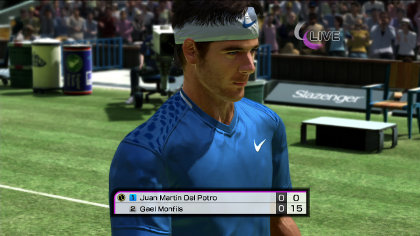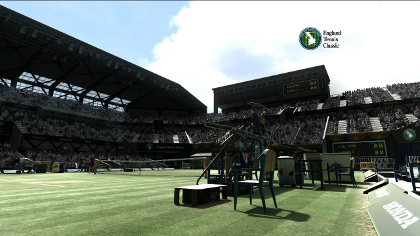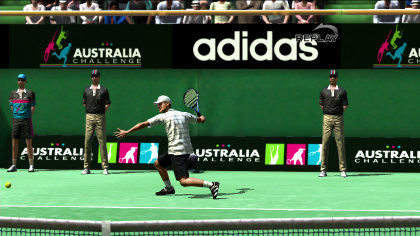As a sport, tennis has found itself as something of a poster child for motion control gaming. Since Wii Tennis convinced an entire generation that they could be front-room Federers, the intuitive pleasures of swinging an imaginary racquet have proved to be a smash with the more active of gamers.
Celebrating its twelfth year now, the Virtua Tennis series is almost a victim of its own success. Having replicated the fine English art of tennis so effortlessly on their first attempt, Sega found the series in an evolutionary dead end, with leaps in character roster and texture resolution merely cherries on top of an already a beautifully complete cake. Following the lukewarm reception the Sumo Digital-developed Virtua Tennis 2009 received, development duties have been handed back to Sega’s legendary AM3 studio, headed up by series’ producer, Mie Kumagai. We briefly caught up with Kumagai on her recent visit to London to discuss the challenges of breathing new life into the classic franchise.

As with Virtua Tennis 3 before it, player detail is beautifully observed. Everything from beads of sweat to popping veins.
Having been at the cutting edge of bringing 1080p gaming to PS3 and Xbox 360 back in 2006, Kumagai explains the most pressing challenges her team faced in approaching Virtua Tennis 4: “Tech-wise, Virtua Tennis 4 is the first time the development team has supported all home platforms at the same time – Wii, 360 and PS3. Adding the motion control through PlayStation Move, Kinect and MotionPlus has doubled the challenge, plus we have completely remade the online system from scratch to provide the best experience possible. Tech-wise it was a huge challenge.”
These are challenges that after hands-on time with the game have been met with varying degrees of success. Working within the boundaries of each console’s idiosyncratic capabilities appears to have produced a clear disparity between versions; and the PS3 takes the grand slam victory. Visually the HD formats obviously take centre court, though the added bonus of 3D means it’s advantage PS3. Sony may have had a difficult time selling 3D to the gaming hardcore, but the benefit of true depth perception in a sport like tennis is undeniable, making for a far more a more playable motion controlled experience.
The PS3 takes the second set too, clearly emerging the victor in the motion control stakes. While both Move and MotionPlus offer the subtleties of slice and top spin, Kinect’s simplistic control scheme does neither, offering perhaps too realistic a simulation of what it would be like to play real tennis with just the palm of your hand. Both HD versions include the ability to approach the net by simply stepping towards your TV – an option that the camera-free Wii can’t replicate.

When playing with motion controls the view switches between thid and first person perspectives. The delicate balance of utilising the licensed players and putting you in the shoes of said player.
One area that all three versions dismiss entirely is the thorny issue of player-controlled movement, and the result is one that vindicates Nintendo’s reductive Wii Tennis approach. Following overwhelmingly negative feedback to player-controlled movement in Virtua Tennis 2009, movement is handled automatically, leaving you to focus purely on those court-splitting returns.
To long-term devotees of the series the whole discussion of motion control is a moot point. Virtua Tennis’ perfectly nuanced digital control scheme has worked flawlessly for over a decade now and many see the entire motion control issue as an unnecessary gimmick. This is an issue Sega have been quick to address, reassuring players that motion controls are only an option for the adventurous rather than the default control scheme for the series from here-on in. The gulf between the two play styles is great, with motion control users unable to play their digital counterparts. In fact the game ships without the option for online motion controlled play, though this is apparently planned for later inclusion via DLC.
Digital players need not feel totally abandoned by the new feature set, as the new match momentum meter is an exclusive feature for traditionalists. As you land successive returns using your player’s trademark shots, you build a meter that when full can be used to unleash a super shot that puts your opponent on the back foot, allowing you to regain momentum in gruelling rallies. The effect is pronounced but never unbalanced and still requires skill on the part of the aggressor to make the shot pay off.

Ten all-new mini-games will be included in the package, along with the return of some old favourites.
The new world tour mode has been rebuilt from scratch, with a specific focus on addressing the complete lack of challenge and variety of VT 2009. Careers are now split into four seasons (America, North Europe, South Europe and Japan) and each season features a unique route across a packed map screen. Working your way up the seeding list will earn tickets to travel to new areas and there are plenty of other ways to kill time such as handling publicity events, signing autographs and even giving money to charity – even the prospect of realistic minor injuries sounds preferable to the monotony of VT 2009’s career.
To end with we ask Kumagai how her experience with the series has changed over the past decade: “It’s been over a decade that I’ve been involved with Virtua Tennis and I feel that the major changes in creating the series have really been limited by technology. When Virtua Tennis first came out on the Dreamcast, people were blown away by the realism of 3D polygon tennis and when we introduced 1080p resolution we really increased minute details like blades of grass on the court and realistic textures on player’s faces. Now we have 3D on the PS3 and the different motion control options, so over the last decade we have always tried to look at the technology to see how we can deliver Virtua Tennis in the most innovative and modern kind of way.”






 Satoru Iwata Video Interview - the late Nintendo president spoke with Kikizo in 2004 as 'Nintendo Revolution' loomed.
Satoru Iwata Video Interview - the late Nintendo president spoke with Kikizo in 2004 as 'Nintendo Revolution' loomed. Kaz Hirai Video Interview - the first of Kikizo's interviews with the man who went on to become global head of Sony.
Kaz Hirai Video Interview - the first of Kikizo's interviews with the man who went on to become global head of Sony. Ed Fries Video Interview - one of Xbox's founders discusses an epic journey from Excel to Xbox.
Ed Fries Video Interview - one of Xbox's founders discusses an epic journey from Excel to Xbox. Yu Suzuki, the Kikizo Interview - we spend time with one of gaming's most revered creators.
Yu Suzuki, the Kikizo Interview - we spend time with one of gaming's most revered creators. Tetris - The Making of an Icon: Alexey Pajitnov and Henk Rogers reveal the fascinating story behind Tetris
Tetris - The Making of an Icon: Alexey Pajitnov and Henk Rogers reveal the fascinating story behind Tetris Rare founders, Chris and Tim Stamper - their only interview? Genuinely 'rare' sit down with founders of the legendary studio.
Rare founders, Chris and Tim Stamper - their only interview? Genuinely 'rare' sit down with founders of the legendary studio. The History of First-Person Shooters - a retrospective, from Maze War to Modern Warfare
The History of First-Person Shooters - a retrospective, from Maze War to Modern Warfare